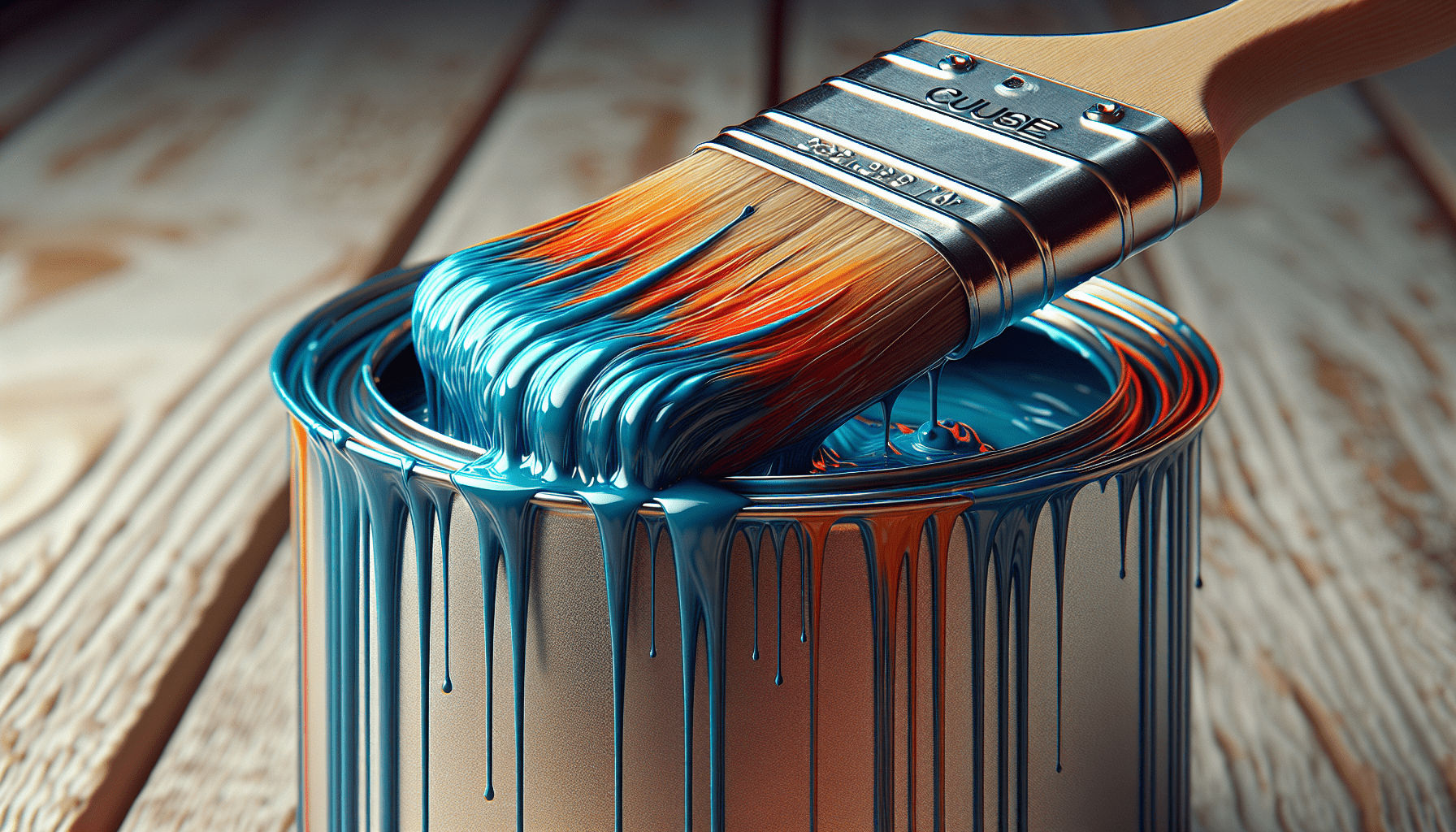Enamel and acrylic paints are two commonly used types of paint in various art and DIY projects. However, when it comes to layering these paints, questions arise about compatibility and the potential for successful outcomes. In this article, we will explore the age-old query: can you paint enamel over acrylic paint? By examining the properties and characteristics of both types of paint, as well as exploring techniques and precautions, we aim to provide a comprehensive answer to this burning question. So, if you have been pondering the feasibility of adding a layer of enamel paint on top of your acrylic masterpiece, read on to discover the possibilities, challenges, and tips for achieving a harmonious fusion between these two mediums.
What is enamel paint?
Definition and characteristics of enamel paint
Enamel paint is a type of paint that is known for its durability and glossy finish. It is typically made by fusing glass powder and pigments, resulting in a hard and smooth surface when it dries. Enamel paint is oil-based and provides a protective coating that is resistant to scratches, moisture, and stains. It is commonly used for painting surfaces that require a tough and glossy finish, such as furniture, metal objects, and trim work.
Uses and benefits of enamel paint
Enamel paint offers several advantages that make it a popular choice for various applications. Its durability makes it suitable for high-traffic areas and objects that are subject to wear and tear. The glossy finish of enamel paint adds a touch of elegance and sophistication to any surface it is applied to. Additionally, enamel paint is resistant to moisture, making it ideal for use in bathrooms, kitchens, and other areas prone to humidity. The protective properties of enamel paint also help to prevent rust and corrosion on metal surfaces.
What is acrylic paint?
Definition and characteristics of acrylic paint
Acrylic paint is a type of water-based paint that consists of pigments suspended in an acrylic polymer emulsion. It is known for its quick-drying properties and versatility. Acrylic paint can be diluted with water or mixed with other mediums to achieve different effects and consistencies. It is available in a wide range of colors and finishes, including matte, satin, and high-gloss. Acrylic paint is commonly used for both artistic and practical purposes, such as painting canvas, wood, walls, and crafts.
Uses and benefits of acrylic paint
Acrylic paint has become a popular choice among artists and DIY enthusiasts due to its flexibility and ease of use. It can be used on various surfaces, including paper, canvas, wood, and metal. Acrylic paint dries quickly, allowing artists to layer colors and create intricate details without waiting for extended periods between applications. It is also known for its vibrant and long-lasting colors, making it an excellent choice for paintings and other artistic projects. Moreover, acrylic paint is water-resistant when it dries, providing a protective barrier against moisture and fading.

Can you paint enamel over acrylic paint?
Understanding the compatibility between enamel and acrylic paints
Painting enamel over acrylic can be quite challenging due to the inherent differences between these two types of paint. Enamel paint is oil-based, while acrylic paint is water-based. Enamel paint forms a hard and glossy finish, while acrylic paint has a more flexible and matte appearance. The compatibility between enamel and acrylic paints depends on various factors, including the surface, the condition of the acrylic paint, and the application method.
Factors to consider before painting enamel over acrylic
Before painting enamel over acrylic, it is essential to consider a few factors to ensure a successful application. Firstly, the condition of the acrylic paint should be evaluated. If the surface is smooth, clean, and free from any imperfections, it is more likely to provide a suitable base for enamel paint. Additionally, the type of surface and the intended use should be taken into account. Certain surfaces, such as plastics, may not adhere well to enamel paint without proper preparation. Finally, the compatibility and drying time of the specific enamel and acrylic paints being used should be considered.
Possible issues and challenges of painting enamel over acrylic
Painting enamel over acrylic can present several challenges and potential issues. One of the primary concerns is the adhesion between the two types of paint. Enamel paint may not adhere properly to an acrylic base if the surface is too smooth or has not been adequately prepared. This can lead to the paint peeling or flaking over time. Another challenge is the difference in drying time. Enamel paint typically takes longer to dry and cure compared to acrylic paint. If the enamel paint is applied before the acrylic paint is completely dry, it may affect the final finish and durability.
Preparing the surface
Cleaning and sanding the acrylic paint
Before applying enamel paint over acrylic, it is crucial to prepare the surface properly. Start by cleaning the acrylic paint using a mild detergent and water solution. This will help remove any dirt, grease, or contaminants that may affect the adhesion of the enamel paint. Once the surface is clean and dry, lightly sand the acrylic paint using fine-grit sandpaper. Sanding creates a rougher texture, allowing the enamel paint to adhere better to the surface. Be sure to remove any sanding dust before proceeding to the next step.
Priming the surface
To further enhance the adhesion and compatibility between enamel and acrylic paints, it is recommended to apply a primer to the surface. Choose a primer specifically designed for the type of surface and paints being used. Apply the primer evenly using a brush or roller, following the manufacturer’s instructions. Priming helps to create a barrier between the acrylic paint and the enamel paint, ensuring better adhesion and preventing any potential interactions between the two types of paint.

Applying enamel paint over acrylic
Choosing the right enamel paint
When selecting enamel paint to apply over acrylic, it is important to choose a high-quality product that is compatible with the acrylic base. Look for enamel paints that are suitable for the desired surface and offer good adhesion to acrylic paints. It is also advisable to choose a color and finish that complement the acrylic paint and the overall aesthetic of the project. Consult with a paint specialist or refer to the manufacturer’s instructions for specific product recommendations.
Applying thin and even coats
To achieve the best results when applying enamel paint over acrylic, it is crucial to apply thin and even coats. Thick layers of paint can affect the drying time and adhesion, leading to potential issues. Start by applying a thin coat of enamel paint using a brush or roller. Allow the first coat to dry completely before applying additional coats. Depending on the desired finish and coverage, multiple coats may be necessary. Ensure that each layer is applied uniformly to maintain a smooth and professional-looking surface.
Drying and curing time
Enamel paint typically takes longer to dry and cure compared to acrylic paint. It is important to allow sufficient drying and curing time between coats and before subjecting the painted surface to any stress or contact. Follow the manufacturer’s instructions for the recommended drying and curing times. Keep in mind that environmental conditions, such as temperature and humidity, can also affect the drying and curing process. Patience and proper ventilation are key to achieving a durable and flawless enamel finish over acrylic.
Tips and tricks for successful application
Testing compatibility on a small area
Before applying enamel paint over a large area of acrylic, it is always a good idea to test the compatibility on a small, inconspicuous area. This will help identify any potential issues or incompatibilities before committing to the entire surface. Apply a small amount of enamel paint over the acrylic, let it dry, and observe how well it adheres and if any adverse reactions occur. If the test area shows signs of poor adhesion or other problems, alternative approaches or products may need to be considered.
Using a primer or adhesion promoter
To enhance the adhesion between enamel and acrylic paints, using a primer or adhesion promoter can be highly beneficial. These products are specifically designed to improve the bond between different types of paint. The primer or adhesion promoter should be compatible with both the enamel and the acrylic paints being used. Apply the primer or adhesion promoter according to the manufacturer’s instructions, ensuring thorough coverage on the surface before proceeding with the enamel paint application.
Applying enamel paint in multiple layers
To achieve a more durable and long-lasting enamel finish over acrylic, consider applying the enamel paint in multiple layers. Applying thin coats and allowing each layer to dry completely before applying the next will result in a stronger and more even finish. Multiple layers also provide an opportunity to correct any imperfections or unevenness in the application. Be patient and follow the recommended drying and curing times between each layer to ensure optimal results.
Common issues and solutions
Peeling or flaking of enamel paint
One of the common issues when painting enamel over acrylic is the peeling or flaking of the enamel paint. This can occur if the surface was not properly prepared or if there was poor adhesion between the two types of paint. To address this issue, it is crucial to ensure that the acrylic paint is clean, sanded, and primed adequately before applying the enamel paint. Using a high-quality enamel paint and following the recommended application techniques can also help prevent peeling or flaking.
Fading or discoloration of acrylic paint
Another potential issue when using enamel paint over acrylic is the fading or discoloration of the acrylic paint. Enamel paint, especially darker colors, may contain strong solvents that can react with the acrylic paint, resulting in color changes or fading. To minimize this risk, it is important to choose enamel paints that are specifically formulated for use over acrylic surfaces. Additionally, applying a primer or adhesion promoter can help create a barrier and reduce the chances of color interactions.
Cracking or blistering
Cracking or blistering of the enamel paint can occur if the drying and curing process is not properly followed. Enamel paint requires a longer drying and curing time compared to acrylic paint. Applying multiple thick coats or subjecting the painted surface to stress before it is fully dry and cured can lead to cracking or blistering. To prevent this issue, ensure that each coat of enamel paint is applied thinly and evenly, and allow sufficient drying and curing time between coats and before handling or using the painted object.
Conclusion
In conclusion, painting enamel over acrylic can be a challenging task due to the differences in composition and properties between these two types of paint. However, with proper preparation, careful selection of compatible products, and following recommended techniques, it is possible to achieve a successful application. By understanding the compatibility factors, preparing the surface adequately, and applying the enamel paint correctly, you can create a durable and aesthetically pleasing finish over acrylic. Taking into consideration the tips, tricks, and potential challenges discussed in this article will increase the likelihood of a successful outcome when painting enamel over acrylic.



